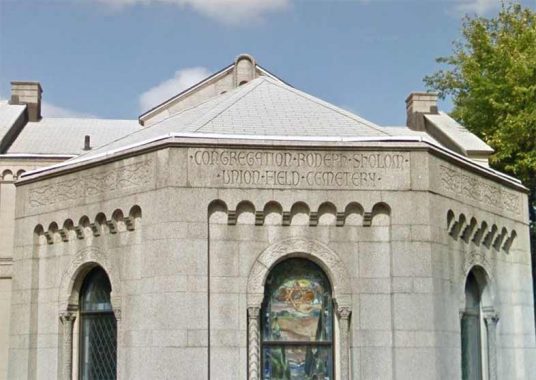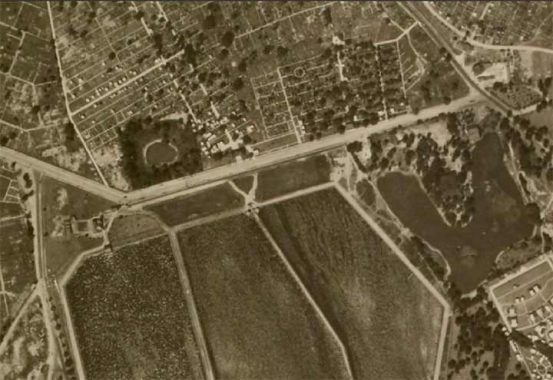
By SERGEY KADINSKY
Forgotten NY correspondent
ALONG the Jackie Robinson Parkway where the Queens-Brooklyn border runs atop the glacial terminal moraine are a set of cemeteries straddling that line, each with their own collection of unique monuments serving as seemingly the last word on the individuals buried here…

I recently attended the burial of a close friend’s mother at Union Field Cemetery in Ridgewood and on that rainy fall afternoon, the setting was reminiscent of a European cemetery. Rather than packing in the deceased as tightly as possible, this graveyard has plenty of trees. Like any good historic cemetery, Union Field has a gatehouse with offices and a chapel.

The Gothic-style building has a unique font spelling out its name. If you know the name of this font, leave a comment below. The cemetery is open to all Jews but it is most closely associated with Rodeph Shalom, a Reform synagogue on the Upper West Side that purchased these 63 acres in 1846 for a cemetery. At the time, state lawmakers were pushing cemeteries out of Manhattan, and with limits on how many acres a cemetery could have, the funerary industry purchased land on the border straddling two counties. The rocky topography was unsuitable for farming but for cemeteries, it meant a parklike setting with views of the city.

In the gatehouse lobby is a plaque from 1927 honoring its top donors. The president of Rodeph Sholom was Henry Goldfogle, a Manhattan Congressman. He was buried in this cemetery in 1929.

On his grave is the inscription “Author of the resolution for the abrogation of the Russian treaty.” Perhaps the proudest achievement of his legislative career, this resolution was in protest of the Russian Empire’s discriminatory policies against Jews. President Theodore Roosevelt sympathized with the Jewish community, but felt that cutting off trade with Russia would come at a high cost to American businesses. Anyway, the resolution did not sway the tsar to improve Russia’s treatment of Jews. but it sent a message of not standing idly by.

Close to the gatehouse there are numerous mausoleums and I have mixed feelings about these structures. With their visibility, a mausoleum allows for better name recognition of the deceased. But they also take up space that could have been reserved for other individuals or greenery. This structure honors Israel Miller, a shoe manufacturer.

The I. Miller Building, at 7th Avenue and 46th Street, was built from 1927-1929 and is nearly unrecognizable underneath the video billboards and garish scaffolding advertising a chain restaurant. Israel Miller’s shoe store was long patronized by theater people.
A look at I. Miller Building seen here in 2012, will prove to be a glimpse into the Great White Way’s past. In 1927 the I. Miller company took a public vote to determine the most popular theater actresses of the day with the idea of placing their statues on their new 7th Avenue store. The results came in and sculptor Alexander Stirling Calder was chosen to depict them in some of their most famous roles… Ethel Barrymore as Hamlet’s Ophelia, singer-dancer Marilyn Miller as Sunny, Mary Pickford as Little Lord Fauntleroy, and soprano Rosa Ponselle as Bellini’s Norma. About a decade ago the likenesses were polished up and rehabilitated.
The Maxell ad, meanwhile, featuring the guy sitting in front of a speaker with his hair and tie blowing back from the force of the sound waves, is pretty venerable itself now — it was first used in 1980, with “Ride of the Valkyries” playing on the TV commercials.

Looking north, the pathway in the cemetery descends on the ridge. The ideal time to visit this cemetery is when the foliage is most colorful. Many Mannheims and Oppenheimers are seen along this road, as Rodeph Shalom was founded by German Jews.

Rabbi Aaron Wise was their spiritual guide between 1876 and 1896. He was born in Hungary, descended from a long line of orthodox rabbis, but upon arriving on these shores, he embraced Reform Judaism.
His son Stephen also became a rabbi, famously turning down a chance at the pulpit at Temple Emanu-El because the sermons had to be approved by the board. He then went across Central Park and founded the Free Synagogue. Did Stephen’s children also become rabbis? His son James was an author and art dealer, and grandson Stephen A. Wise was an attorney. He was married to Abby, a Presbyterian, had his funeral in a church and was then cremated. Seems like the end for that family’s long Jewish lineage.

In contrast, this cemetery also honors Rabbi Jacob Joseph, the first and last Chief Rabbi of New York. His humble grave is hidden between Bachrach and Altschul. His story here began in 1888, when 18 orthodox congregations in Manhattan elected this Lithuanian scholar to be their unifying authority, tasked with enforcing kosher standards. His tenure was a tragedy as most kosher butchers rejected his guidelines and he had no power to enforce them; not all orthodox synagogues recognized his title and neither did the Reformists. For these reasons the title of Chief Rabbi died with him.
His son Raphael also served as a rabbi, grandson Lazarus Joseph served as the city comptroller, and namesake grandson Capt. Jacob Joseph was killed in combat. A playground on the Lower East Side perpetuates his name. Another grandson, Robert L. Joseph was a playwright. He did not have children.

The Fischel monument is partially a cenotaph, with Jane Fischel buried here in 1935 but her husband Harry was buried in 1947 at Mount of Olives in Jerusalem. He was one of the earliest orthodox Jewish millionaires in this country, an example that one can achieve financial success without compromising his religious values. The Fischels had four daughters. To ensure that his last name lives on, he was a massive philanthropist to Jewish causes.
His daughters married men who shared their religious values and they have many descendants today living here and in Israel.
As legacies are concerned, the Rabbi Jacob Joseph School on Staten Island continues to perpetuate his ideals, while the Stephen Wise Free Synagogue on the Upper West Side does the same for its namesake.

The mausoleum of the Tauszig-Roger’s family is unusual as it is an Egyptian Revival, a popular style in the 19th and early 20th centuries. I am not surprised to see such tombs at Woodlawn and Green-Wood, but the ancient Egyptians enslaved Jews and tried to murder all the firstborn boys, too. Nevertheless it was a popular choice for tombs and perhaps a statement on America. As good as it is to live here, it is as much a diaspora home as Egypt. Maybe our slavish devotion to money borders on idolatry. Nicholas Tauszig was a chemist and his wife Tillie was an active member of Rodeph Sholom.

Rosa and Julius Stern were not a famous couple but I found their wedding ring tombstone design inspiring. In sickness and in health, in life and in death, they remain together.
German Jews are known for preserving their lineage, expressing pride in their genealogy. Salomon and Hulda Lesser’s gravestone notes that they were born in Exin, Prussia which corresponds to today’s Kcynia, Poland.

Last names were bestowed on the general population in the early 19th century by Prussian authorities, just before Salomon Lesser was born. Lesser is derived from Eliezer, Salomon’s father. Among his many descendants is Rabbi Uri Lesser of West Hempstead, who happens to be his great-great-great-great-grandson. Outside of aristocracy and those who inherited generational wealth, most folks can’t name an ancestor so distant, but the Lesser family can! Credit to the rabbi’s father, Dr. Robert Lesser, for sharing these details.
[I wonder if Len Lesser, “Uncle Leo” on Seinfeld, is related? –Ed.]

Besides individuals, Jewish cemeteries have gateways indicating group plots belonging to family circles and landsmanshaften, associations of immigrants originating from the same town that functioned as mutually funded burial societies. My parents’ cemetery has a detailed list of its burial societies. Most of these societies died out over the decades. The Simiaticher Sick and Benevolent Association represented newcomers from Siemiatycze, a town in eastern Poland.
There are many other names to see at Union Field Cemetery, such as mobster Arnold Rothstein and Roy Cohn, an early mentor to Donald Trump, but I was there for the funeral of Mrs. Goldsmith, mother of a close friend whose family has plots here dating back a century. We take comfort that she is at rest among so many individuals who left a lasting impact on society.

Having written a book on the city’s hidden waterways and knowing the topography of a knob-and-kettle terrain, the cemetery belt had a handful of ponds that were eventually filled in favor of grave space or the parkway, such as Delta Lake and Banzer’s Pond. The Bromley atlas from 1909 shows some of these ponds and the Ridgewood Reservoir. Enveloped by Union Field Cemetery was an unnamed pond that belonged to the city. At the time, the hills between Evergreens and Cypress Hill cemetery was a patchwork of smaller cemeteries and residences.

In the 1924 aerial survey by the city’s Engineering Bureau, the pond is visible. Cypress Avenue runs past the pond, carrying a streetcar line that brought mourners to this cemetery. Interborough Parkway (later renamed for Jackie Robinson) would later cut through Cypress Hills Cemetery, but the other cemeteries on this ridge were not affected by its construction.

The site of the unnamed pond is included within Union Field Cemetery, an overgrown section used for parking maintenance vehicles.
You can learn more about the history of this cemetery and individuals named here by visiting each of the hyperlinks posted in the essay above.
Sergey Kadinsky is the author of Hidden Waters of New York City: A History and Guide to 101 Forgotten Lakes, Ponds, Creeks, and Streams in the Five Boroughs (2016, Countryman Press), adjunct history professor at Touro University and the webmaster of Hidden Waters Blog.
As always, “comment…as you see fit.” I earn a small payment when you click on any ad on the site. Take a look at the new JOBS link in the red toolbar at the top of the page on the desktop version, as I also get a small payment when you view a job via that link.
12/15/24


5 comments
I heard the free synagogue of flushing is based on the philosophy of Stephan wise
It may not be in this cemetery, but I do know one of them of this very highway has a the grave of Jackie Robinson himself, so it sort of made sense to rename the highway after him.
Thanks for this. Much of my paternal side — going back to one great grandparent buried in 1934 — is interred here,
many in a single large plot at the rear of the cemetery. Until abut 15 years ago, one could see the Manhattan skyline
from this plot.
For more on the cemetery belt:
Kevin documented National Cemetery in 2012
Gave a tour of Evergreen Cemetery in 2012
Traveled on Cypress Hills Street in 2011
And Marie Carter visited Most Holy Trinity Cemetery in 2018
My grandparent’s house and oddly-shaped lot at the top of 62nd Street bordered the cemetery. On the map above, their house was at the southwest corner of the old Meyer property.